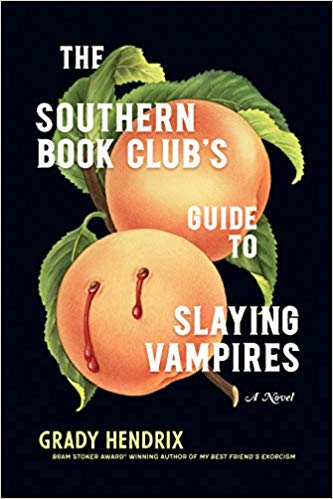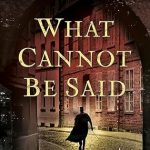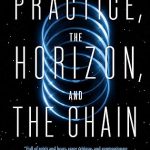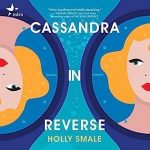 The Southern Book Club's Guide to Slaying Vampires by Grady Hendrix
The Southern Book Club's Guide to Slaying Vampires by Grady Hendrix Format: eARC
Source: supplied by publisher via Edelweiss, supplied by publisher via NetGalley
Formats available: hardcover, ebook, audiobook
Genres: horror, vampires
Pages: 404
Published by Quirk Books on April 7, 2020
Purchasing Info: Author's Website, Publisher's Website, Amazon, Barnes & Noble, Kobo, Bookshop.org
Goodreads
Fried Green Tomatoes and "Steel Magnolias" meet Dracula in this Southern-flavored supernatural thriller set in the '90s about a women's book club that must protect its suburban community from a mysterious and handsome stranger who turns out to be a blood-sucking fiend.
Patricia Campbell had always planned for a big life, but after giving up her career as a nurse to marry an ambitious doctor and become a mother, Patricia's life has never felt smaller. The days are long, her kids are ungrateful, her husband is distant, and her to-do list is never really done. The one thing she has to look forward to is her book club, a group of Charleston mothers united only by their love for true-crime and suspenseful fiction. In these meetings, they're more likely to discuss the FBI's recent siege of Waco as much as the ups and downs of marriage and motherhood.
But when an artistic and sensitive stranger moves into the neighborhood, the book club's meetings turn into speculation about the newcomer. Patricia is initially attracted to him, but when some local children go missing, she starts to suspect the newcomer is involved. She begins her own investigation, assuming that he's a Jeffrey Dahmer or Ted Bundy. What she uncovers is far more terrifying, and soon she--and her book club--are the only people standing between the monster they've invited into their homes and their unsuspecting community.
My Review:
This was exactly what I was expecting when picking up horror. But the friends who recommended it to me mentioned the words “laughing” and “humor” in relation to this book, and I just didn’t get any of either.
What I did get read like a really odd twist on the first book in the Sookie Stackhouse series – and I know that sounds insane. But really, we have a tight-knit Southern community where an unattached but charismatic man turns up, moves in, can’t manage sunlight and has been around a LOT longer than anyone thinks. Admittedly, when James Harris moves into this neighborhood, he makes Bill the Vampire seem like a big, ole pussycat. Because Bill doesn’t come to Bon Temps to prey on the locals, while James Harris has that plan in mind from the very beginning – and he’s ruthless in carrying it out.
But the story isn’t the monster’s story. Instead, it’s the story of the group of suburban women who band together, first to read true crime and murder mysteries, and then to deal with the unreal but absolutely true crime that has invaded their very own little town.
The portrayal of the women’s friendships, through all their ups and downs, was the real highlight of the story. But the way that they not only turn on each other, but turn on their own very selves, was a big part of the sadness. None of their husband’s are remotely worthy of them, as they prove over the course of the story.
They have all caged themselves, and it takes a monster, and a monster’s rampage, to finally get them to set themselves free. They’ve spent their lives cleaning up men’s messes, after all, and they are damn good at it. Which is a good thing, because this monster left one big damn mess.
Escape Rating C: Most readers seem to have loved this book. Certainly all the people who recommended it to me did. And I really did need to read it for reasons that I can’t get into. And I did finish and the ending was compelling. Getting to that point was less so, at least for this reader.
Part of the reason that I didn’t enjoy this book is that it reminded me of all the reasons I don’t normally read horror. It was gruesome and terrible things were happening and nobody wants to believe the book club members and no one wants to pay attention to what’s going wrong.
But it felt like all of the reasons that no one wanted to pay attention had to do with the women themselves. They were all small and narrow and put upon and put down and disregarded in their own lives. They didn’t pay attention to themselves or each other and no one else did either. They were dismissed at every turn, not just by society as a whole, but by their husbands and children. They didn’t believe each other and they didn’t believe in themselves.
Also, this is supposed to be a satire of suburban life in the 90s, but to me it felt flat. Probably because this just didn’t read like the 90s. During the 90s, I was in my late 30s, so relatively close in age to the members of the book club, but I was divorced, childfree and working. I worked in a female dominated profession, so ALL the women I knew worked. Many had stepped out when their kids were very young, but had returned to work at some point when their kids got a bit older, as the children of these women already had. It was difficult if not impossible to maintain a suburban life with multiple children without both spouses working. So for this reader their lives were small, sad and unrealistic and that colored my opinion of the whole book. Your experience of that time period may certainly vary, and your reaction may be entirely different. If this had been set in the 1960s or earlier I would have had a different reaction. I would have still felt the sadness and smallness, but it would have fit better into the times.
I did like, well, not the villain, you’re not supposed to like the villain, but that the monster didn’t exactly fit into any preconceived versions of monster. He’s referred to as a vampire, but it felt more in the sense that some people are emotional vampires sucking the life out of everyone around them. Not that he didn’t suck blood, but he also put it back. It’s complicated. But he didn’t just take blood, he took everything. He was a force of eternal hunger, always wanting more, always taking advantage, always leaving destruction in his wake. And we never do discover how he came to be. Or whether or not he actually came to end.
So that part was cool. But he also represented the way that the men in these women’s lives had also sucked them dry and left devastation in their wakes, and that leads me back to sad, and a bit disappointed. Your reading mileage may definitely vary.



















I don’t remember the 90s like that either, though I was an at-home mom. My world wasn’t small or sucked dry by anyone. Without having read it, it sounds like someone’s idea of what it was like. Thanks for the review!
Based on some of the author’s comments, it may have been intended as the kids’ view of 90s adulthood and their mothers in particular. But as a whole it felt very misogynistic in ways that just made me cringe. I also remember at least one recession and a lot of well-educated folks temporarily out-of-work. This place just wasn’t real.
Marlene Harris recently posted..Memorial Day 2020